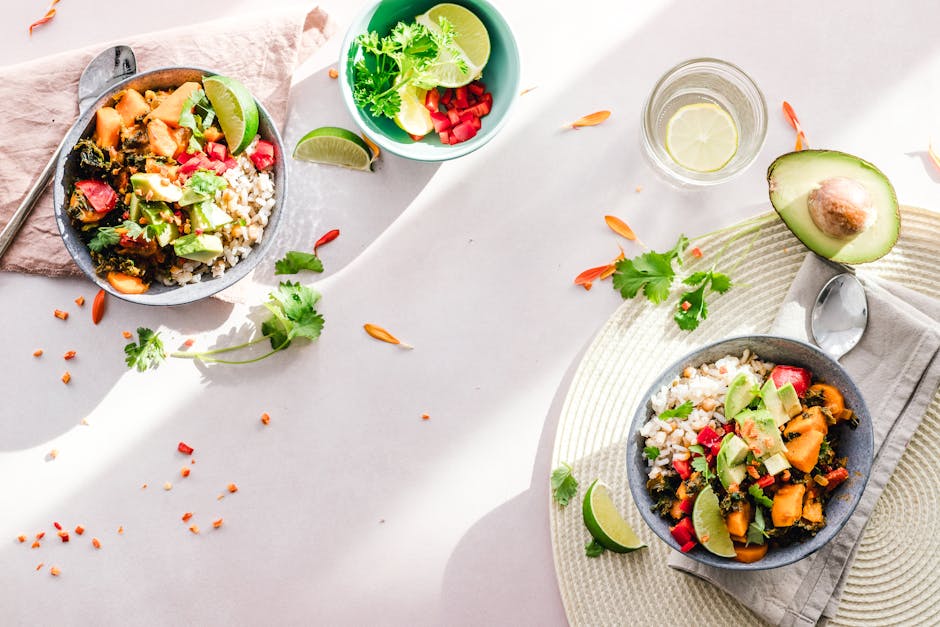Keto Diet Beginner Tips

Keto Diet Beginner Tips
Benefits of Starting a Keto Diet
So you’ve heard about the keto diet and you’re curious to give it a try. You’ve seen all the success stories and the amazing transformations, and you’re ready to jump on the bandwagon. But before you dive in headfirst, it’s important to understand the benefits of starting a keto diet.
One of the biggest benefits of the keto diet is weight loss. By drastically reducing your carbohydrate intake and increasing your fat intake, your body enters a state of ketosis where it burns fat for fuel instead of glucose. This can lead to rapid weight loss, especially in the first few weeks of starting the diet.
But weight loss isn’t the only benefit of the keto diet. Many people report increased energy levels, improved mental clarity, and better focus when following a ketogenic diet. This is because ketones, which are produced when your body is in ketosis, are a more efficient source of energy for your brain than glucose.
In addition to these cognitive benefits, the keto diet has also been shown to have positive effects on various health conditions. Studies have found that the keto diet can help lower blood sugar levels, reduce inflammation, and improve cholesterol levels. It has also been used as a therapeutic diet for epilepsy, Alzheimer’s disease, and certain types of cancer.
Another benefit of the keto diet is its ability to control hunger and cravings. By eating a diet high in fat and protein, you’ll feel more satisfied and less likely to overeat. This can make it easier to stick to your diet and avoid the temptation of unhealthy foods.
One of the best things about the keto diet is that it’s not just a short-term fix. Many people find that they can easily maintain their weight loss and continue to see improvements in their health by following a ketogenic lifestyle long-term. This is because the keto diet is sustainable and can be adapted to fit your individual needs and preferences.
If you’re thinking about starting a keto diet, there are a few tips that can help you get started on the right foot. First, make sure to do your research and educate yourself about the basics of the keto diet. Understanding how the diet works and what foods are allowed can help you make informed choices and set realistic goals for yourself.
It’s also important to be patient and give your body time to adjust to the changes. The first few days or weeks of starting a keto diet can be challenging as your body transitions from using glucose to using ketones for fuel. You may experience symptoms like fatigue, headaches, and irritability, but these usually subside once your body adapts to the new way of eating.
Lastly, don’t be afraid to experiment and find what works best for you. The keto diet is highly customizable, and there are many different ways to approach it. Some people prefer to track their macros and calories, while others prefer to keep it simple and focus on eating whole, unprocessed foods. Find what works for you and stick with it.
In conclusion, the keto diet offers a wide range of benefits for those looking to improve their health and lose weight. By understanding the basics of the diet, being patient with your body, and finding what works best for you, you can set yourself up for success on your keto journey. So why wait? Start reaping the benefits of the keto diet today!
Common Mistakes to Avoid When Starting Keto
So you’ve decided to jump on the keto bandwagon and give this high-fat, low-carb diet a try. Congratulations! The keto diet can be a great way to kickstart weight loss, improve energy levels, and even boost mental clarity. However, like any new lifestyle change, there are some common mistakes that beginners often make when starting out on the keto diet. In this article, we’ll cover some of these pitfalls and offer tips on how to avoid them.
One of the biggest mistakes that beginners make when starting the keto diet is not tracking their macros. Macros, short for macronutrients, are the three main components of food: fat, protein, and carbohydrates. On the keto diet, it’s important to keep track of your macros to ensure that you are eating the right balance of these nutrients. A common guideline for the keto diet is to consume 70-75% of your calories from fat, 20-25% from protein, and 5-10% from carbohydrates. By tracking your macros, you can make sure that you are staying within these ranges and maximizing the benefits of the keto diet.
Another mistake that beginners often make is not drinking enough water. When you are on the keto diet, your body goes into a state of ketosis, where it burns fat for fuel instead of carbohydrates. This process can lead to dehydration, as your body excretes more water than usual. To prevent dehydration and keep your body functioning properly, it’s important to drink plenty of water throughout the day. Aim for at least 8-10 glasses of water per day, and more if you are exercising or in a hot climate.
One common misconception about the keto diet is that you can eat as much fat as you want and still lose weight. While it’s true that the keto diet is high in fat, it’s important to remember that calories still matter. Eating too many calories, even if they are from healthy fats, can stall weight loss and even lead to weight gain. To avoid this mistake, focus on eating high-quality, nutrient-dense fats like avocados, nuts, and olive oil, and be mindful of portion sizes.
Another mistake that beginners often make on the keto diet is relying too heavily on processed keto-friendly foods. While there are many convenient keto snacks and products on the market, these items are often high in artificial ingredients, preservatives, and unhealthy fats. To truly reap the benefits of the keto diet, focus on whole, unprocessed foods like meat, fish, eggs, vegetables, and healthy fats. Not only will this help you stay in ketosis, but it will also support your overall health and well-being.
Finally, one of the biggest mistakes that beginners make on the keto diet is giving up too soon. Like any new lifestyle change, the keto diet can take some time to adjust to. You may experience symptoms like fatigue, headaches, and cravings as your body adapts to burning fat for fuel. However, these symptoms are usually temporary and will improve as your body becomes keto-adapted. If you’re struggling in the beginning, don’t be discouraged. Reach out to a support group, a nutritionist, or a keto coach for guidance and encouragement. With time and patience, you can successfully navigate the challenges of the keto diet and achieve your health and weight loss goals.
In conclusion, the keto diet can be a powerful tool for improving your health and well-being. By avoiding common mistakes like not tracking your macros, staying hydrated, watching your calorie intake, choosing whole foods over processed products, and staying committed even when the going gets tough, you can set yourself up for success on the keto diet. Remember, everyone’s journey is unique, so be patient with yourself and listen to your body as you embark on this new chapter in your health and wellness journey. Good luck!
Easy Keto-Friendly Recipes for Beginners
So you’ve decided to give the keto diet a try – congratulations! This low-carb, high-fat diet has gained popularity in recent years for its potential weight loss and health benefits. But starting a new diet can be overwhelming, especially if you’re not sure where to begin. Don’t worry, I’ve got you covered with some beginner tips to help you navigate the world of keto.
First things first, it’s important to understand the basics of the keto diet. The goal of the keto diet is to put your body into a state of ketosis, where it burns fat for fuel instead of carbohydrates. To achieve this, you’ll need to drastically reduce your carb intake and increase your fat intake. A typical keto diet consists of about 70-75% fat, 20-25% protein, and 5-10% carbs.
One of the most important things to keep in mind when starting the keto diet is to focus on whole, nutrient-dense foods. This means avoiding processed foods, sugar, and grains, and instead opting for foods like meat, fish, eggs, nuts, seeds, and low-carb vegetables. It’s also important to stay hydrated and make sure you’re getting enough electrolytes, especially in the beginning stages of the diet when your body is adjusting to the changes.
Meal planning is key when following the keto diet, so take some time to plan out your meals and snacks for the week. This will help you stay on track and avoid reaching for unhealthy options when you’re hungry. There are plenty of keto-friendly recipes available online, so don’t be afraid to get creative in the kitchen.
When it comes to cooking keto-friendly meals, there are a few key ingredients you’ll want to have on hand. Some staples of the keto diet include coconut oil, olive oil, butter, avocados, and low-carb sweeteners like stevia or erythritol. You’ll also want to stock up on protein sources like chicken, beef, and fish, as well as plenty of low-carb vegetables like spinach, broccoli, and cauliflower.
If you’re new to the keto diet, it’s normal to experience some side effects in the beginning as your body adjusts to burning fat for fuel. This can include symptoms like fatigue, headaches, and irritability, often referred to as the “keto flu.” To help alleviate these symptoms, make sure you’re staying hydrated, getting enough electrolytes, and getting plenty of rest.
As you continue on your keto journey, don’t be afraid to experiment with different recipes and meal ideas. There are plenty of delicious and satisfying keto-friendly options out there, so you don’t have to feel like you’re missing out on your favorite foods. From keto-friendly pizza to low-carb desserts, there are endless possibilities when it comes to eating on the keto diet.
Remember, the key to success on the keto diet is consistency and patience. It may take some time for your body to fully adapt to the changes, but with dedication and perseverance, you can achieve your health and weight loss goals. So don’t be afraid to dive in and give the keto diet a try – you might just be surprised at the results.

